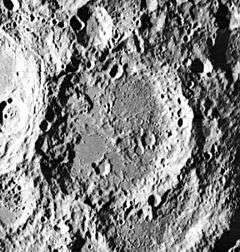Heaviside (lunar crater)
Heaviside is a large lunar impact crater that is located on the far side of the Moon. It is attached to the eastern rim of the equally large walled plain Keeler, although Keeler is somewhat less eroded. To the northwest lies the crater Stratton, and to the southeast is the prominent Aitken.
 Lunar Orbiter 2 image | |
| Coordinates | 10.4°S 167.1°E |
|---|---|
| Diameter | 165 km |
| Depth | Unknown |
| Colongitude | 196° at sunrise |
| Eponym | Oliver Heaviside |
The outer wall of Heaviside has been worn and eroded by subsequent impacts, particularly to the north and south. Only the eastern rim remains relatively intact, while the western rim has been slightly distorted by the adjacent Keeler impact.
The relatively flat interior floor is marked by many small craterlets and rugged terrain to the southeast and west. The most notable of these are the satellite craters Heaviside N in the south, Heaviside Z in the north, and the bowl-shaped Heaviside E near the eastern rim.
Satellite craters
By convention these features are identified on lunar maps by placing the letter on the side of the crater midpoint that is closest to Heaviside.
| Heaviside | Latitude | Longitude | Diameter |
|---|---|---|---|
| B | 5.5° S | 169.3° E | 23 km |
| C | 5.7° S | 171.1° E | 28 km |
| D | 6.7° S | 171.8° E | 18 km |
| E | 10.2° S | 169.2° E | 12 km |
| F | 10.8° S | 172.8° E | 14 km |
| K | 13.3° S | 168.5° E | 110 km |
| N | 11.8° S | 166.6° E | 18 km |
| Z | 8.8° S | 166.8° E | 12 km |
References
- Andersson, L. E.; Whitaker, E. A. (1982). NASA Catalogue of Lunar Nomenclature. NASA RP-1097.CS1 maint: ref=harv (link)
- Blue, Jennifer (July 25, 2007). "Gazetteer of Planetary Nomenclature". USGS. Retrieved 2007-08-05.CS1 maint: ref=harv (link)
- Bussey, B.; Spudis, P. (2004). The Clementine Atlas of the Moon. New York: Cambridge University Press. ISBN 978-0-521-81528-4.CS1 maint: ref=harv (link)
- Cocks, Elijah E.; Cocks, Josiah C. (1995). Who's Who on the Moon: A Biographical Dictionary of Lunar Nomenclature. Tudor Publishers. ISBN 978-0-936389-27-1.CS1 maint: ref=harv (link)
- McDowell, Jonathan (July 15, 2007). "Lunar Nomenclature". Jonathan's Space Report. Retrieved 2007-10-24.CS1 maint: ref=harv (link)
- Menzel, D. H.; Minnaert, M.; Levin, B.; Dollfus, A.; Bell, B. (1971). "Report on Lunar Nomenclature by the Working Group of Commission 17 of the IAU". Space Science Reviews. 12 (2): 136–186. Bibcode:1971SSRv...12..136M. doi:10.1007/BF00171763.CS1 maint: ref=harv (link)
- Moore, Patrick (2001). On the Moon. Sterling Publishing Co. ISBN 978-0-304-35469-6.CS1 maint: ref=harv (link)
- Price, Fred W. (1988). The Moon Observer's Handbook. Cambridge University Press. ISBN 978-0-521-33500-3.CS1 maint: ref=harv (link)
- Rükl, Antonín (1990). Atlas of the Moon. Kalmbach Books. ISBN 978-0-913135-17-4.CS1 maint: ref=harv (link)
- Webb, Rev. T. W. (1962). Celestial Objects for Common Telescopes (6th revised ed.). Dover. ISBN 978-0-486-20917-3.CS1 maint: ref=harv (link)
- Whitaker, Ewen A. (1999). Mapping and Naming the Moon. Cambridge University Press. ISBN 978-0-521-62248-6.CS1 maint: ref=harv (link)
- Wlasuk, Peter T. (2000). Observing the Moon. Springer. ISBN 978-1-85233-193-1.CS1 maint: ref=harv (link)